华为合作伙伴 IT产品手册_存储产品分册
- 格式:pdf
- 大小:6.72 MB
- 文档页数:18
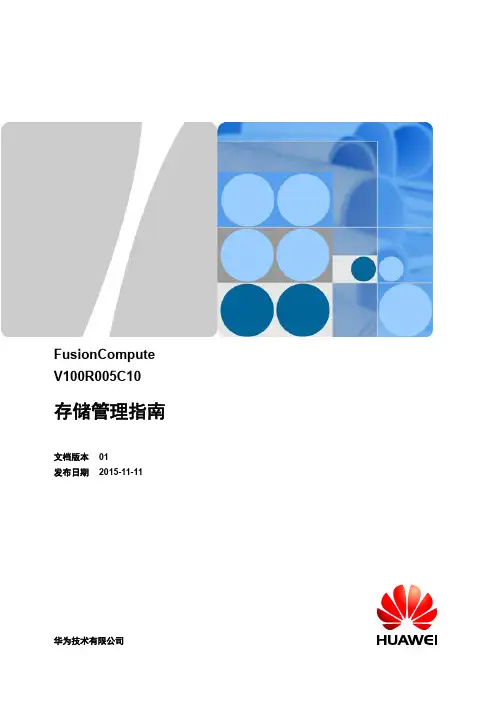
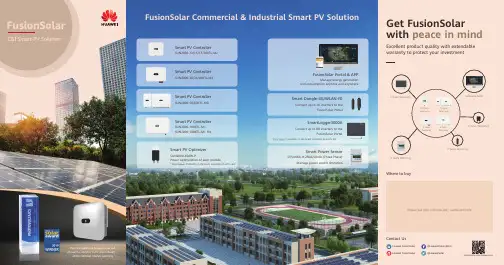
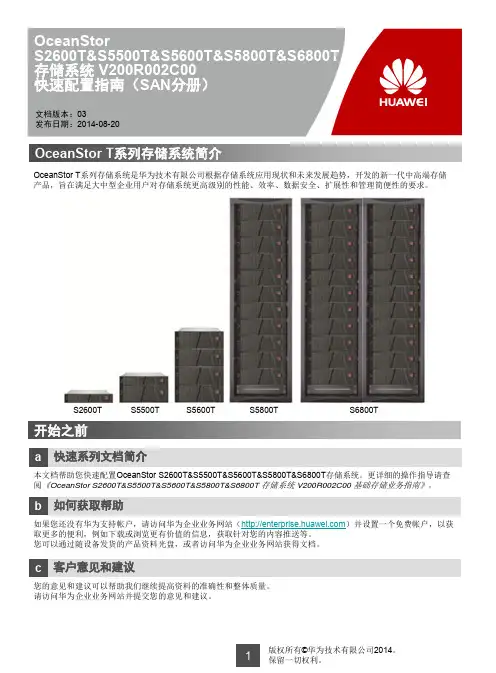
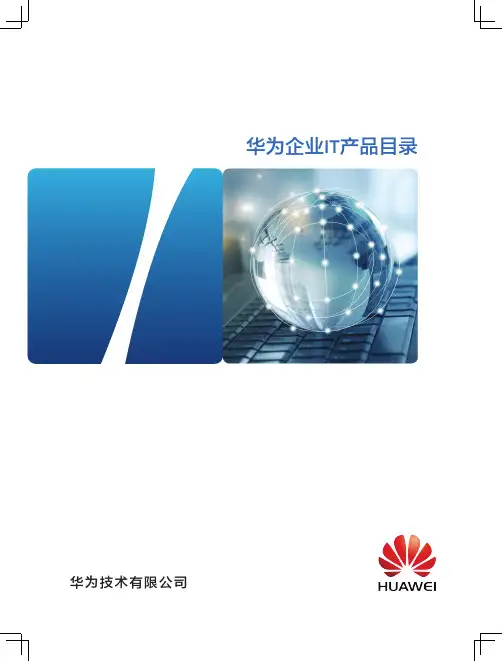
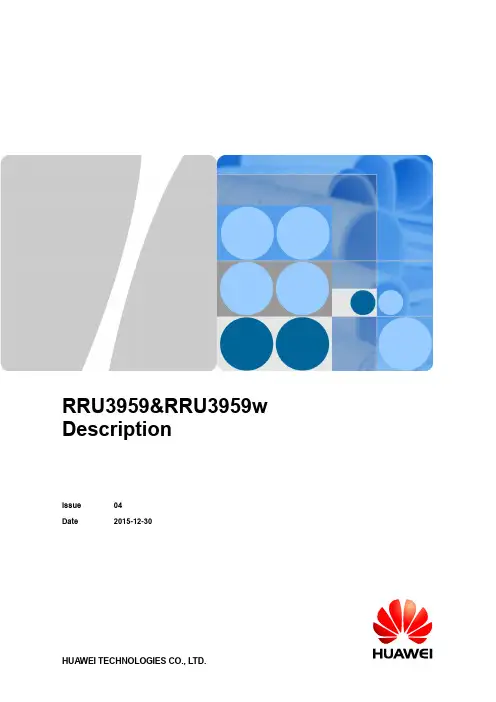
RRU3959&RRU3959w DescriptionIssue 04Date 2015-12-30Copyright © Huawei Technologies Co., Ltd. 2015. All rights reserved.No part of this document may be reproduced or transmitted in any form or by any means without prior written consent of Huawei Technologies Co., Ltd.Trademarks and Permissionsand other Huawei trademarks are trademarks of Huawei Technologies Co., Ltd.All other trademarks and trade names mentioned in this document are the property of their respective holders.NoticeThe purchased products, services and features are stipulated by the contract made between Huawei and the customer. All or part of the products, services and features described in this document may not be within the purchase scope or the usage scope. Unless otherwise specified in the contract, all statements, information, and recommendations in this document are provided "AS IS" without warranties, guarantees or representations of any kind, either express or implied.The information in this document is subject to change without notice. Every effort has been made in the preparation of this document to ensure accuracy of the contents, but all statements, information, and recommendations in this document do not constitute a warranty of any kind, express or implied.Huawei Technologies Co., Ltd.Address: Huawei Industrial BaseBantian, LonggangShenzhen 518129People's Republic of ChinaWebsite: Email: ******************RRU3959&RRU3959w Description ContentsContents1 Overview (1)1.1 Appearance (1)1.2 Physical Ports (2)2 Technical Specifications (4)2.1 Frequency Band (4)2.2 Capacity (4)2.3 Receiver Sensitivity (5)2.4 Output Power (6)2.5 Power Consumption (19)2.6 Input Power (20)2.7 Equipment Specifications (21)2.8 CPRI Port Specifications (21)2.9 Environment Specifications (22)3 Acronyms and Abbreviations (23)1 OverviewThe RRU3959/RRU3959w is an outdoor remote radio unit which is powered by a powercabinet. It is the RF module of the distributed base station and is installed close to the antenna.The RRU3959/RRU3959w performs modulation, demodulation, data processing, andcombination and division of baseband signals and RF signals. By using the software-definedradio (SDR) technology, the RRU3959 can work in GU, GL or UL dual-mode throughsoftware configurations, the RRU3959w can work in GL dual-mode through softwareconfigurations.The RRU3959/RRU3959w has a dual-transmitter and dual-receiver design, which furtherimproves the output power and the carrier capacity.The software version of the RRU3959(900MHz/1800MHz) is SRAN10.1, which iscompatible with the N-1 and N-2 versions of MBTS, MBSC, and OSS NEs. Therefore, theRRU3959 can be used with products of SRAN8.0, SRAN9.0 and SRAN10.1 versions. Allthese three versions include the RRU3959 software components. The RRU3959 used inSRAN8.0, SRAN9.0 and SRAN10.1 has no impact on the KPI of products.The software version of the RRU3959(2100MHz) is SRAN11.0, which is compatible with theN-1 and N-2 versions of MBTS, MBSC, and OSS NEs. Therefore, the RRU3959 can be usedwith products of SRAN9.0, SRAN10.1 and SRAN11.0 versions. All these three versionsinclude the RRU3959 software components. The RRU3959 used in SRAN9.0, SRAN10.1 andSRAN11.0 has no impact on the KPI of products.The software version of the RRU3959w is SRAN10.1, which is compatible with the N-1versions of MBTS, MBSC, and OSS NEs. Therefore, the RRU3959w can be used withproducts of SRAN9.0 and SRAN10.1 versions. All these two versions include the RRU3959wsoftware components. The RRU3959w used in SRAN9.0 and SRAN10.1 has no impact on theKPI of products.1.1 AppearanceFigure 1-1 shows the appearance of the RRU3959/RRU3959w.Figure 1-1Appearance of the RRU3959/RRU3959w1.2 Physical PortsRRUs have a modular design. Its external ports are located in the cabling cavity or at thebottom of the module.Figure 1-2 shows the physical ports on the RRU3959/RRU3959w and Table 1-1 describesthese ports.Figure 1-2Physical ports on the RRU3959/RRU3959w2 Technical Specifications 2.1 Frequency BandTable 2-1RRU3959/RRU3959w frequency band2.2 CapacityTable 2-2Single-mode capacityTable 2-3Multi-mode capacity2.3 Receiver SensitivityTable 2-4RRU3959/RRU3959w receiver sensitivityNOTE●The receiver sensitivity of GSM, as recommended in 3GPP TS 51.021, is measured in the centralband at the antenna connector on condition that the channel rate is 13 kbit/s and the bit error rate(BER) is not higher than 2%●The receiver sensitivity of UMTS, as recommended in 3GPP TS 25.104, is measured in the entireoperating band at the antenna connector on condition that the channel rate reaches 12.2 kbit/s andthe bit error rate (BER) is not higher than 0.001.●The receiver sensitivity of LTE, as recommended in 3GPP TS 36.104, is measured under a 5 MHzchannel bandwidth based on the FRC A1-3 in Annex A.1 (QPSK, R = 1/3, 25 RBs) standard.2.4 Output PowerNOTE●RRU3959/RRU3959w working in GSM mode and in the 900 MHz/1800 MHz frequency bandcomply with the standard EN 301 502 V9.2.1. RRU3959/RRU3959w modules working in UMTS,LTE or multi-standard radio (MSR) mode and in the 900 MHz/1800 MHz frequency band complywith the standards ETSI EN 301 908 V5.2.1, 3GPP TS 37.104 and 3GPP TS 37.141.●For the RRU3959/RRU3959w working in GSM mode: When the S1 or S2 configuration is used andthe maximum output power is 60 W per carrier, the corresponding 60 W power license must beobtained.●The output power is 1 dB less than the standard power when the RRU3959/RRU3959w is located ata height of 3500 m to 4500 m; and is 2 dB less than the standard power when theRRU3959/RRU3959w is located at a height of 4500 m to 6000 m.●Factors such as the inter-site distance, frequency reuse factor, power control algorithm, and trafficmodel affect the gain achieved by dynamic power allocation. Therefore, in most cases, the networkplanning can be based on the power specification achieved by dynamic power allocation.●In the power sharing mode, the power control and DTX functions must be enabled.In GBSS8.1, thedynamic power sharing feature is mutually exclusive with the GBFD-113201 Concentric Cell,GBFD-114501 Co-BCCH Cell, GBFD-118001 BCCH Dense Frequency Multiplexing, andGBFD-117501 Enhanced Measurement Report (EMR) features. In GBSS9.0 and later versions, thedynamic power sharing feature can be used together with these features.However, the dynamicpower sharing feature currently cannot be used together with the GBFD-117002 IBCA (InterferenceBased Channel Allocation), GBFD-117001 Flex MAIO, GBFD-118701 RAN Sharing, andGBFD-114001 Extended Cell features in GBSS8.1, GBSS9.0, and later versions.●Power sharing assumes a random distribution of UEs in the cell.●The output power per carrier in the output power tables indicates the maximum output powersupported by the network performance.●When two LTE carriers are configured, it is recommended that the power spectrum density (PSD) ofthe two carriers be set to the same value. Power spectrum density = Carrier output power/Carrierbandwidth (1.4 MHz and 3 MHz bandwidths are considered as 5 MHz bandwidth in this formula.)●For RRU3959w, the scenario where the third-order intermodulated signal falls in the receivefrequency range of a configured carrier is not supported.Table 2-5, Table 2-6, and Table 2-7 show the typical output power for the RRU3959supporting the 900 MHz frequency band and the following modes: GO, UO, and GU.Table 2-5 and Table 2-8 show the typical output power for the RRU3959 supporting the 1800MHz frequency band and the following modes: GO, LO, and GL.Table 2-5 and Table 2-8 show the typical output power for the RRU3959 supporting the 2100MHz frequency band and the following modes: UO, LO, and UL.Error! Reference source not found. and Error! Reference source not found. show thetypical output power for the RRU3959w supporting the 1800 MHz frequency band and thefollowing modes: GO, LO, and GL.Table 2-5Typical output power for the RRU3959 (900 MHz/1800 MHz, single-mode)Table 2-6Typical output power for the RRU3959 (900 MHz, GU non-MSR)Table 2-7Typical output power for the RRU3959 (900 MHz, GU MSR)Table 2-8Typical output power for the RRU3959 (1800 MHz, GL MSR)Table 2-9Typical output power for the RRU3959(2100 MHz, single-mode)Table 2-10Typical output power for the RRU3959(2100MHz,UL MSR)Table 2-11Typical output power for the RRU3959w (1800 MHz, single-mode)Table 2-12Typical output power for the RRU3959w (1800 MHz, GU non-MSR)Table 2-13Typical output power for the RRU3959w (1800 MHz, GU MSR)Table 2-14Typical output power for the RRU3959w (1800 MHz, GL MSR)2.5 Power ConsumptionNOTE●The typical power consumption and the maximum power consumption are measured when the basestation works at a temperature of 25°C.●The typical power consumption for GSM is reached when the base station works with 30% load.The maximum power consumption for GSM is reached when the base station works with 100%load.●The typical power consumption for UMTS is reached when the base station works with 40% load.The maximum power consumption for UMTS is reached when the base station works with 100%load.●The typical power consumption for LTE is reached when the base station works with 50% load. Themaximum power consumption for LTE is reached when the base station works with 100% load.●This section describes the power consumption of an entire base station. Board configurations in aBBU are as follows:-GSM: one GTMU-UMTS: one UMPTb1 and one WBBPf3 in 3x1 and 3x2 scenarios, one UMPTb1 and twoWBBPf3s in 3 x 3 and 3 x 4 scenarios.-LTE FDD: one UMPTb1 and one LBBPd1 when one carrier is configured.Table 2-15Power consumption of the DBS3900 (V er.D) (–48 V) (configured with the RRU3959,900 MHz)Table 2-16Power consumption of the DBS3900 (V er.D) (–48 V) (configured with the RRU3959,1800 MHz)Table 2-17Power consumption of the DBS3900 (V er.D)( –48 V)(configured with the RRU3959,2100MHz)2.6 Input PowerTable 2-18Input power2.7 Equipment SpecificationsTable 2-19Equipment specifications2.8 CPRI Port SpecificationsTable 2-20CPRI port specifications2.9 Environment SpecificationsTable 2-21Environment specificationsRRU3959&RRU3959w Description 3 Acronyms and Abbreviations3 Acronyms and AbbreviationsTable 3-1Acronyms and abbreviations。
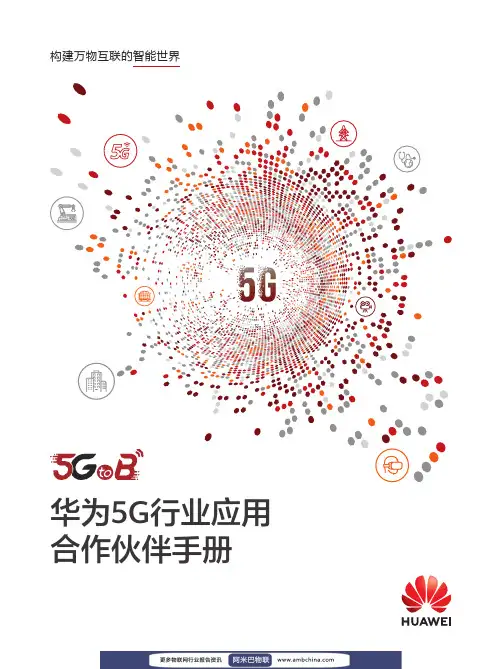
构建万物互联的智能世界华为5G行业应用合作伙伴手册目录CONTENT5G工业通信模组 03成都鼎桥通信技术有限公司 03中移物联网有限公司 04上海移远通信技术股份有限公司 05四川爱联科技有限公司 07利尔达科技集团股份有限公司 08深圳市宗立科技有限公司 095G行业通信终端 10成都鼎桥通信技术有限公司 10利尔达科技集团股份有限公司 11中微普业科技有限公司 12厦门四信通信科技有限公司 13深圳市宏电技术股份有限公司 155G天线 16尚远科技(中国)有限公司 16智能制造 17杭州海康机器人技术有限公司 17杭州蓝芯科技有限公司 20杭州南江机器人股份有限公司 21北京微视新纪元科技有限公司 22苏州振畅智能科技有限公司 24杭州汇萃智能科技有限公司 25凌华科技(中国)有限公司 26深圳市鑫赛科科技发展有限公司 27智能物流 28昆船智能技术股份有限公司 28深圳市今天国际物流技术股份有限公司 29智慧煤矿 31北京唐柏通讯技术有限公司 31上海山源电子科技股份有限公司 3301华为5G行业应用合作伙伴手册02华为5G 行业应用合作伙伴手册华为5G 垂直行业生态圈 57媒体直播 44高骏(北京)科技有限公司 44天津德力仪器设备有限公司 45上海通维通讯网络科技有限公司 46智慧城市 47青岛云世纪信息科技有限公司 47杭州迅蚁网络科技有限公司 48摩联科技 49贝壳 · 如视 50智慧电力 51北京映翰通网络技术股份有限公司 51AR 52亮风台(上海)信息科技有限公司 52杭州灵伴科技有限公司 53测试工具 55ROHDE&SCHWARZ(罗德与施瓦茨) 55北京星河亮点技术股份有限公司 56智慧医疗 40上海联影医疗科技有限公司 40深圳华大智造云影医疗科技有限公司 41苏州康多机器人有限公司 42苏州协同创新医用机器人研究院 43北京慧拓无限科技有限公司 35北京踏歌智行科技有限公司 37八达电气有限公司 38天津华宁电子有限公司 3903华为5G 行业应用合作伙伴手册成都鼎桥通信技术有限公司公司名称:成都鼎桥通信技术有限公司邮箱:************************网址:/合作伙伴简介成都鼎桥通信技术有限公司(以下称“鼎桥”)于2011年11月18日在成都高新区成立,在北京、上海和成都三地设立研发中心,拥有员工1200人(成都800人),注册资本6.5亿人民币。
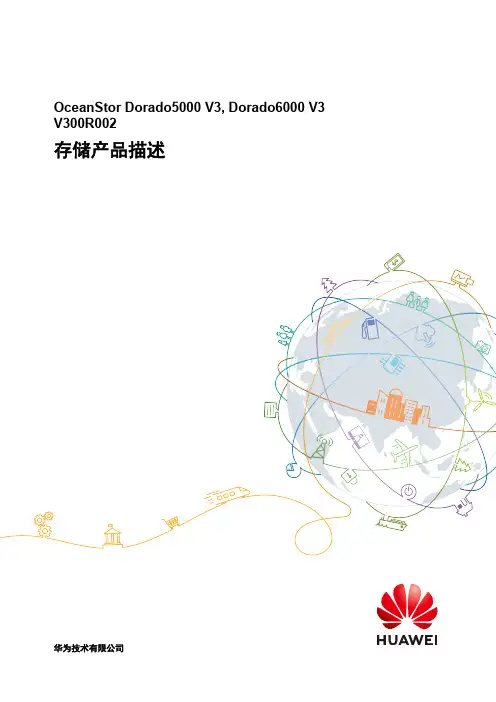
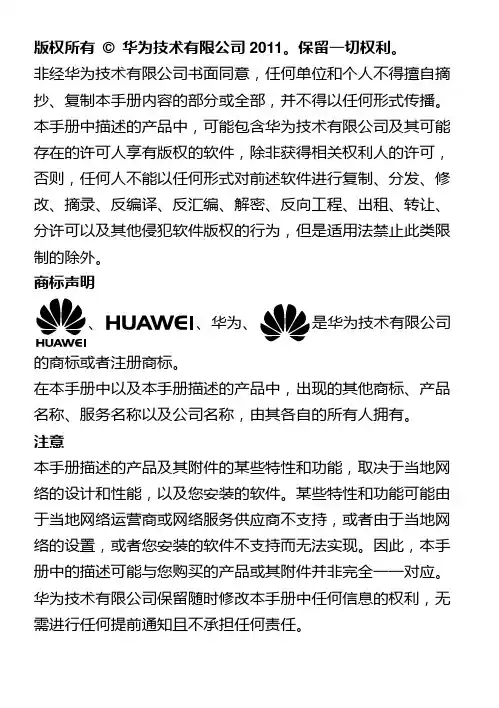
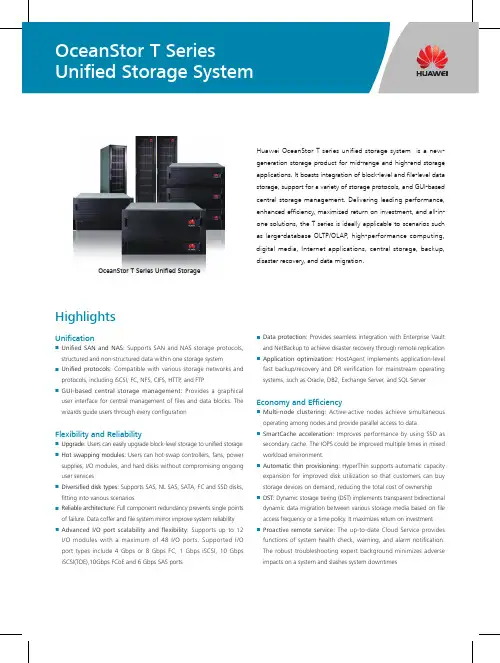
OceanStor T Series Unified StorageHighlightscationUnified SAN and NAS: Supports SAN and NAS storage protocols, structured and non-structured data within one storage system Unified protocols: Compatible with various storage networks and protocols, including iSCSI, FC, NFS, CIFS, HTTP, and FTPGUI-based central storage management:Provides a graphical user interface for central management of fi les and data blocks. The wizards guide users through every con fi gurationFlexibility and ReliabilityUpgrade: Users can easily upgrade block-level storage to uni fi ed storage Hot swapping modules: Users can hot-swap controllers, fans, power supplies, I/O modules, and hard disks without compromising ongoing user servicesDiversified disk types: Supports SAS, NL SAS, SATA, FC and SSD disks, tting into various scenariosReliable architecture: Full component redundancy prevents single points of failure. Data coffer and fi le system mirror improve system reliability Advanced I/O port scalability and flexibility: Supports up to 12ModelS2600TS5500TS5600TS5800TBlock Storage Component Storage processor Multi-core processors Cache size8GB/16GB 8GB/16GB/32GB 24GB/48GB 96GB/192GB Extended cache1.2TB 1.2TB2.4TB3.6TBNumber of controllers 2Front-end port types 8Gbps FC, 1Gbps iSCSI, 10Gbps Iscsi(TOE)8Gbps FC, 1Gbps iSCSI, 10Gbps iSCSI (TOE), 10Gbps FCoE Back-end port types 6Gbps SAS 2.0 wide port 6Gbps SAS 2.0 wide port 4Gbps FC,6Gbps SAS 2.0 wide port 4Gbps FC,6Gbps SAS 2.0 wide port Number of onboard I/O ports Front end: 12 x 1 Gbps iSCSI ports;Back end: 4 x SAS 2.0 wide ports Front end: 8 x 8 Gbps Fibre Channel ports;Back end: 4 x SAS 2.0 wide ports 00Maximum. number of I/O modules221012Maximum number of disk slots 27652811521440Supported disk types SAS, NL SAS, SATA, SSD SAS, NL SAS, SATA, SSD SAS, NL SAS, SATA, SSD,FC SAS, NL SAS, SATA, SSD,FC RAID levels0,1, 3, 5, 6, 10, 50Maximum number of snapshots 256102420482048Maximum number of LUNs 2048409640968192Mobile Management Supported.N/A N/A N/A TurboModule Supported.Functional software HyperImage (snapshot),HyperCopy (LUN copy), HyperClone (split mirror), HyperMirror (synchronous/asynchronous remote replication), HyperThin (thin provisioning), UltraPath (multipathing), DiskGuard (host-side data protection), SmartCache (dynamic data caching in TurboBoost)File Storage Component Number of file engine nodes 22, 42, 4, 62, 4, 6, 8Cache size per node 16GB 16GB 24GB 24GB File softwareDST (dynamic storage tiering), Snapshot (file system snapshot), Mirror (file system mirror),Replication (file system remote replication), Symantec NetBackup Client (embedded Symantec network backup client)ProtocolFC, iSCSI, NFS, CIFS, FTP , HTTPCompatible operating system Including AIX, HP-UX, Solaris, Linux, WindowsVirtual Environment Virtual machine VMware, Citrix, Hyper-VValue-added feature VMware VAAI support for VSphere and VCenter integrationPhysical Specifications Power supplyAC: 100 V to 127 V, or 200 V to 240 V DC: –60 V to –48 VArray power consumption 2 U controller enclosure: ≤380W4 U controller enclosure: ≤527W2 U controller enclosure: ≤ 539W2 U disk enclosure: ≤307W4 U disk enclosure: ≤ 527W4 U controller enclosure: ≤598W 2 U disk enclosure: ≤307W 4 U disk enclosure: ≤527W File engine power consumption 4 U file engine: ≤ 800WArray dimensions (H x W x D)2 U controller enclosure: 86.1mm x 446mm x 582mm 4 U controller enclosure: 175mm x 446mm x 502mm 4 U disk enclosure: 175mm%446mm%412mm 2 U disk enclosure: 86.1mm x 446mm x 412mm 4 U disk enclosure: 175mm x 446mm x 412mm File engine dimensions (H x W x D) 4 U, 175mm x 446mm x 502mmWeight2U Controller enclosure≤ 22.98kg4U Disk enclosure ≤ 25.2kgController enclosure ≤ 23.9kg 2 U SAS disk enclosure ≤ 14.9kg 4 U SAS disk enclosure≤ 25.2kg Controller enclosure ≤ 43.6kg2 U SAS disk enclosure ≤ 14.9kg4 U SAS disk enclosure ≤ 25.2kg4 U FC disk enclosure ≤ 24.9kgTechnical Speci ficationsHUAWEI TECHNOLOGIES CO., LTD.Huawei Industrial BaseBantian LonggangShenzhen 518129, P .R. ChinaTel: +86-755-28780808Copyright © Huawei Technologies Co., Ltd. 2013. All rights reserved.THIS DOCUMENT IS FOR INFORMATION PURPOSE ONLY, AND DOES NOT CONSTITUTE ANY KIND OF WARRANTIES.。
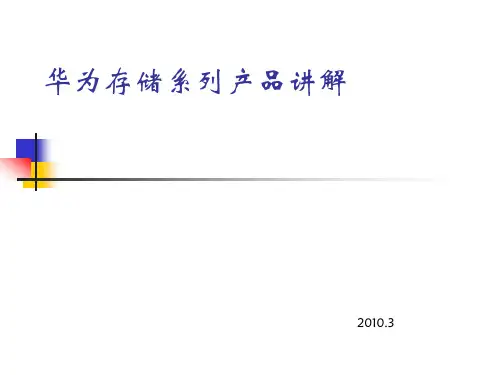

Copyright © Huawei Technologies Co., Ltd. 2016.All rights reserved.No part of this manual may be reproduced or transmitted in any form or by any means without prior written consent of Huawei Technologies Co., Ltd. And its affiliates (“Huawei”).The product described in this manual may include copyrighted software of Huawei and possible licensors. Customers shall not in any manner reproduce, distribute, modify, decompile, disassemble, decrypt, extract, reverse engineer, lease, assign, or sublicense the said software, unless such restrictions are prohibited by applicable laws or such actions are approved by respective copyright holders.Trademarks and Permissions, , and are trademarks or registered trademarks of Huawei Technologies Co., Ltd.Other trademarks, product, service and company names mentioned are the property of their respective owners.NoticeSome features of the product and its accessories described herein rely on the software installed, capacities and settings of local network, and therefore may not be activated or may be limited by local network operators or network service providers.Thus, the descriptions herein may not exactly match the product or its accessories which you purchase. Huawei reserves the right to change or modify any information or specifications contained in this manual without prior notice and without any liability.DISCLAIMERALL CONTENTS OF THIS MANUAL ARE PROVIDED “AS IS”. EXCEPT AS REQUIRED BY APPLICABLE LAWS, NO WARRANTIES OF ANY KIND, EITHER EXPRESS OR IMPLIED, INCLUDING BUT NOT LIMITED TO, THE IMPLIED WARRANTIES OF MERCHANTABILITY AND FITNESS FOR A PARTICULAR PURPOSE, ARE MADE IN RELATION TO THE ACCURACY, RELIABILITY OR CONTENTS OF THIS MANUAL.TO THE MAXIMUM EXTENT PERMITTED BY APPLICABLE LAW, IN NO EVENT SHALL HUAWEI BE LIABLE FOR ANY SPECIAL, INCIDENTAL, INDIRECT, OR CONSEQUENTIAL DAMAGES, OR LOSS OF PROFITS, BUSINESS, REVENUE, DATA, GOODWILL SAVINGS OR ANTICIPATED SAVINGS REGARDLESS OF WHETHER SUCH LOSSES ARE FORSEEABLE OR NOT.THE MAXIMUM LIABILITY (THIS LIMITATION SHALL NOT APPL Y TO LIABILITY FOR PERSONAL INJURY TO THE EXTENT APPLICABLE LAW PROHIBITS SUCH A LIMITATION) OF HUAWEI ARISING FROM THE USE OF THE PRODUCT DESCRIBED IN THIS MANUAL SHALL BE LIMITED TO THE AMOUNT PAID BY CUSTOMERS FOR THE PURCHASE OF THIS PRODUCT.Import and Export RegulationsCustomers shall comply with all applicable export or import laws and regulations and will obtain all necessary governmental permits and licenses in order to export, re-export or import the product mentioned in this manual including the software and technical data therein.Privacy PolicyTo better understand how we protect your personal information, please see the privacy policy at /privacy-policy.ContentsGetting to Know the ME919Bs-567a (1)HUAWEI ME919B L TE LGA Module Development Kit Guide ....................... 错误!未定义书签。
OceanStor N8500集群NAS存储系统产品技术白皮书Issue V2.1Date 2019-12-28华为技术有限公司版权所有 ? 华为技术有限公司 2012。
保留一切权利。
非经本公司书面许可,任何单位和个人不得擅自摘抄、复制本文档内容的部分或全部,并不得以任何形式传播。
商标声明和其他华为商标均为华为技术有限公司的商标。
本文档提及的其他所有商标或注册商标,由各自的所有人拥有。
注意您购买的产品、服务或特性等应受华为公司商业合同和条款的约束,本文档中描述的全部或部分产品、服务或特性可能不在您的购买或使用范围之内。
除非合同另有约定,华为公司对本文档内容不做任何明示或默示的声明或保证。
由于产品版本升级或其他原因,本文档内容会不定期进行更新。
除非另有约定,本文档仅作为使用指导,本文档中的所有陈述、信息和建议不构成任何明示或暗示的担保。
华为技术有限公司为客户提供全方位的技术支持,用户可与就近的华为办事处联系,也可直接与公司总部联系。
华为技术有限公司地址:深圳市龙岗区坂田华为总部办公楼 邮编:518129 网址:客户服务电话:客户服务传真:客户服务邮箱: Support@目录1 概述 .......................................................................................................................................2 N8500集群NAS存储系统架构 ...........................................................................................2.1 产品逻辑结构.......................................................................................................................................2.2 集群NAS软件.....................................................................................................................................2.3 集群NAS引擎.....................................................................................................................................2.4 交换设备配置.......................................................................................................................................2.5 存储单元配置.......................................................................................................................................2.6 管理子系统...........................................................................................................................................3 组网以及环境要求 .................................................................................................................3.1 集群NAS存储系统.............................................................................................................................3.2 NAS/SAN一体化典型组网..................................................................................................................3.3 数据备份组网.......................................................................................................................................3.4 系统运行环境.......................................................................................................................................4 软件特性 .................................................................................................................................4.1 集群文件系统.......................................................................................................................................4.1.1 技术背景 .....................................................................................................................................4.1.2 技术原理 .....................................................................................................................................4.1.3 技术特点 .....................................................................................................................................4.2 快照技术...............................................................................................................................................4.2.1 技术背景 .....................................................................................................................................4.2.2 技术原理 .....................................................................................................................................4.2.3 技术特点 .....................................................................................................................................4.3 动态分级存储技术...............................................................................................................................4.3.1 技术背景 .....................................................................................................................................4.3.2 技术原理 .....................................................................................................................................4.3.3 技术特点 .....................................................................................................................................4.4 远程复制技术.......................................................................................................................................4.4.1 技术背景 .....................................................................................................................................4.4.2 技术原理 .....................................................................................................................................4.4.3 技术特点 .....................................................................................................................................4.5 配额管理技术.......................................................................................................................................4.5.1 技术背景 .....................................................................................................................................4.5.2 技术原理 .....................................................................................................................................4.5.3 技术特点 .....................................................................................................................................图目录图 1 产品逻辑结构图................................................................................................................................图 2 FileStore 软件及应用架构示意图...................................................................................................图 3 N8500集群NAS存储系统关系图..................................................................................................图 4 SAN、NAS一体化典型组网 ...........................................................................................................图 5 使用NBU客户端备份方式组网 .....................................................................................................图 6 使用NDMP备份组网......................................................................................................................图7 数据通道全互联技术........................................................................................................................图8 通信通道全互联技术........................................................................................................................图9 全局存储空间管理技术....................................................................................................................图10 高效的集群锁技术 .........................................................................................................................图11 对称式元数据处理技术 .................................................................................................................图12 全局名字空间技术 .........................................................................................................................图13 集群多节点并发访问技术 .............................................................................................................图14 主文件系统及其快照文件集 .........................................................................................................图15 新生成快照 .....................................................................................................................................图16 主文件系统数据更新 .....................................................................................................................图17 对快照进行数据更新 .....................................................................................................................图18 N8500多卷文件系统示意图..........................................................................................................图19 N8500远程复制技术实现步骤......................................................................................................图20 N8500远程复制技术实现机制......................................................................................................图29 配额管理逻辑架构 ..........................................................................................................................图30 配额管理执行方式 ..........................................................................................................................1 概述传统NAS系统存在扩展性差、可靠性差等缺陷。
华为合作协议模板甲方(合作方):____________________________________________________公司名称:_______________________________________________________注册地址:________________________________________________________法定代表人:_____________________________________________________联系电话:__________________________________________________________邮箱:_______________________________________________________________乙方(华为公司):_____________________________________________________公司名称:_______________________________________________________注册地址:________________________________________________________法定代表人:_____________________________________________________联系电话:__________________________________________________________邮箱:_______________________________________________________________鉴于甲乙双方希望在平等互利的基础上,就共同开发、推广和销售__________________产品/服务达成合作协议,特签订本协议。
2019年认证级华为授权培训合作伙伴(HALP)合作协议甲方:华为技术有限公司乙方:协议编号:签约日期:协议目录协议目录 (2)第一章协议说明 (3)第二章协议标的 (3)第三章协议价格 (4)第四章费用结算和支付方式 (5)第五章责任和义务 (5)第六章质量要求 (8)第七章知识产权和保密 (8)第八章用户隐私保护 (10)第九章不可抗力 (11)第十章违约责任 (11)第十一章协议的变更和终止 (11)第十二章争议解决 (12)第十三章协议生效 (12)第十四章其它约定事项 (12)附件一:2019华为授权培训合作伙伴(HALP)认证标准 (14)附件二:2019年HALP授权年费与加盟费收费标准 (16)附件三:华为授权培训项目清单及授权区域的说明 (17)附件四:HALP登记注册表 (21)附件五:HALP考核管理办法(2019年) (23)第一章协议说明1.1根据《中华人民共和国合同法》,甲乙双方遵循自愿、公平、合法、诚信的原则签订本协议。
1.2甲方和乙方是本协议的独立合同协议方,不得因本协议规定而被解释为法律上的代理、合伙、合资、聘用或任何种类的正式商业组织。
乙方不得代表甲方与任何第三方签订任何口头或书面的协议或以任何方式约束甲方。
乙方不得在任何情况下声称其是甲方的代表,并且在所有与客户直接或间接相关的来往函件和其他行为中,乙方均应明确表示其行为为其单方的行为。
1.3尽管甲方授权乙方进行本协议下的培训项目,双方的关系在任何情况下都不具有民法意义上通常所理解的代理性质。
因此,乙方做出的或乙方雇员、乙方合作伙伴等做出的任何违反本协议的行为是独立于甲方授权行为之外的乙方行为,由乙方独立承担法律后果或乙方与其合作伙伴连带承担法律后果,即乙方对其行为向第三方负责并独立承担全部的法律责任。
第二章协议标的2.1经过甲方对乙方的资质认证,认为乙方具备实施甲方授权相关培训项目的能力,且乙方已经支付甲方授权费用的前提下,甲方授权乙方在下表所列的授权期限、授权区域及授权技术方向大类内开展华为职业认证培训和售后方向的华为专业认证培训项目:2.1.1授权期限:2019年01月01日至2019年12月31日2.1.2授权合作级别:认证级华为授权培训合作伙伴2.1.3授权区域及授权技术方向:甲方授权乙方的培训项目和说明见《附件三:华为授权培训项目清单及授权区域的说明》2.2甲方的授权仅限于乙方在授权期限和区域内实施授权的培训项目,不包括甲方其它相关的授权;乙方行为不代表甲方公司的行为。
存储基础知识白皮书目录第1章网络存储主要技术 (5)1.1 概述 (5)1.2 DAS:直接附加存储 (5)1.3 SAN:存储区域网络 (6)1.3.1 什么是SAN? (7)1.3.2 SAN的误区 (7)1.3.3 SAN的组成 (7)1.3.4 FC SAN的问题 (8)1.3.5 IP SAN (8)1.4 NAS:网络附加存储 (10)1.5 SAN和NAS (11)第2章主要协议和相关技术 (12)2.1 SCSI (12)2.2 FC(光纤通道) (12)2.3 iSCSI (14)2.4 iSCSI与光纤通道的比较 (15)第3章文件系统相关知识 (17)3.1 什么是文件系统 (17)3.2 主流文件系统和特点 (18)3.3 NFS和CIFS网络文件系统工作原理和特点 (22)3.4 存储系统与文件系统的关系 (23)第4章RAID技术 (24)4.1 RAID概述 (24)4.2 RAID级别 (24)4.2.1 RAID0 (24)4.2.2 RAID1 (25)4.2.3 RAID2 (26)4.2.4 RAID3 (26)4.2.5 RAID4 (27)4.2.6 RAID5 (27)4.2.7 RAID6 (28)4.2.8 RAID10 (29)4.2.9 RAID01 (30)4.2.10 JBOD (30)4.3 不同RAID级别对比 (31)第5章主机系统高可用技术 (33)5.1 概述 (33)5.1.1 双机热备份方式 (35)5.1.2 双机互备份方式 (40)5.1.3 群集并发存取方式 (41)5.2 工作模式 (43)5.2.1 双机热备份方式 (43)5.2.2 双机互备方式 (43)5.2.3 群集并发存取方式 (43)5.3 适用场合 (44)5.4 对存储系统的要求 (44)第6章数据一致性 (46)6.1 数据一致性概述 (46)6.2 Cache引起的数据一致性问题 (46)6.3 时间不同步引起的数据一致性问题 (47)6.4 文件共享中的数据一致性问题 (48)第7章数据复制与容灾 (49)7.1 灾难恢复/业务连续性 (49)7.2 数据备份系统 (52)7.2.1 数据备份 (52)7.2.2 数据复制 (54)7.3 数据一致性 (57)7.4 总结 (58)第8章备份技术 (59)8.1 什么是备份 (59)8.2 备份与拷贝、归档的区别 (59)8.3 常规备份的实现方式 (60)8.4 LAN Free和Serverless备份 (61)8.5 主流备份软件和介质 (62)8.6 备份技术新趋势 (66)第9章存储连接设备 (69)9.1 HBA卡介绍 (69)9.1.1 FC HBA相关知识: (69)9.1.2 主要HBA卡厂商 (70)9.1.3 iSCSI HBA相关知识: (70)9.1.4 iSCSI HBA和TOE网卡主要厂商 (71)9.2 FC连接设备介绍 (71)9.2.1 FC HUB相关知识: (71)9.2.2 FC Switch相关知识: (71)9.2.3 FC Director相关知识: (71)9.2.4 iSCSI-FC存储路由器 (72)9.2.5 FC Switch和FC Director主要厂商 (72)第10章信息生命周期 (72)10.1 什么是信息生命周期 (72)10.2 信息生命周期的实现 (73)10.3 实现ILM的技术保障和面临的挑战 (73)10.4 信息生命周期管理现状 (74)10.5 法规遵从与信息生命周期管理 (74)10.6 与信息生命周期相关的存储技术 (75)10.6.1 固定内容管理: (75)10.6.2 WORM: (75)10.7 怎样看待信息生命周期管理 (75)第11章其他存储技术及标准 (76)11.1 SMI-S (76)11.2 CDP(持续数据保护) (77)11.3 虚拟存储 (77)11.4 网格计算 (78)11.5 高性能计算 (78)11.6 负载均衡 (78)第12章常见主机及操作系统 (79)12.1 主机架构及操作系统概述 (79)12.1.1主机架构 (79)12.1.2操作系统 (79)12.1.3操作系统比较 (80)12.2 常见主机厂商及常见产品介绍 (80)12.2.1 IBM: (80)12.2.2 SUN: (81)12.2.3 Fujitsu: (82)12.2.4 HP: (82)12.3 操作系统应用特点 (83)第13章常见数据库及应用系统 (84)13.1 数据库厂商介绍 (84)13.1.1 Oracle (84)13.1.2 DB2 (89)13.1.3 Sybase (92)13.1.4 MS SQL Server (93)第1章网络存储主要技术1.1 概述存储系统是整个IT系统的基石,是IT技术赖以存在和发挥效能的基础平台。
华为产品手册近年来,华为持续推出华为 Mate、P 系列以及华为 Watch 等产品,为消费者带来了更加便利、实用的使用体验。
而华为产品手册也因此得以应运而生,成为了消费者了解华为产品的重要途径之一。
本文将按照类别划分,为您介绍华为产品手册中的内容。
I. 产品介绍类在这一类别中,华为产品手册主要以文字、图片等形式向消费者介绍其产品的基本情况,包括产品名称、使用方式、配件等信息。
例如,在华为新款手表 Huawei Watch GT 2 Pro Pro手册中,可详细阐述其功能特点、技术规格等信息,让消费者全面了解产品性能,从而做出更好的选择。
II. 操作指南类在这一类别中,华为产品手册主要以操作指南的形式,对消费者如何使用其产品进行详细介绍,以及如何解决使用过程中可能遇到的问题进行解释。
例如,在华为手机 Mate 40 Pro 的产品手册中,就为消费者提供了包括如何将手机连接到WLAN等详细的操作指南,方便消费者快速上手使用。
III. 保修服务类在这一类别中,华为产品手册主要介绍其产品在使用过程中的保修服务政策,如保修期、保修范围等内容。
同时,也会向消费者介绍如何进行售后服务的操作流程以及维修指南等相关服务,为消费者的使用体验提供保障。
IV. 产品互通性介绍类在这一类别中,华为产品手册主要介绍不同华为产品之间的互通,例如智能手表与智能手机之间的连接方式、音乐播放等功能互动等。
这样的介绍能够给消费者提供更加便捷、高效的使用方式,从而提升使用体验。
总之,华为产品手册作为一种重要的产品信息介绍途径,为消费者提供了全面的产品信息,让消费者能够更加准确清晰地了解自己所购买的产品,从而更好地使用和维护产品。
同时,我们也期望华为能够持续改进和创新自己的产品手册内容,为消费者带来更多的方便和实用价值。